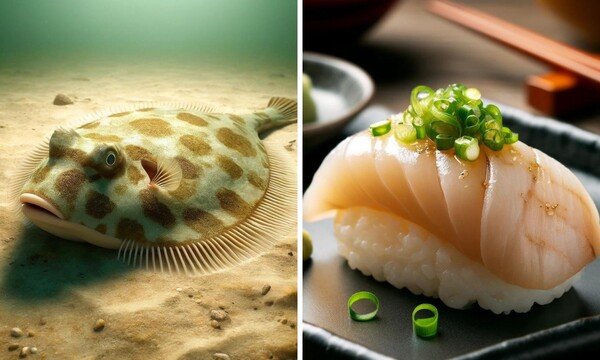Hirame: The Delicacy of the Sea

Hirame is a highly valued fish in Japanese cuisine. Its refined flavour profile and delicate, smooth texture make it a favourite among sushi and sashimi lovers. This guide will explore Hirame’s characteristics, culinary applications, and health benefits. You’ll have a newfound appreciation for this exquisite fish by the end.
What is Hirame?
Understanding Hirame
Hirame, also known as flounder, is a prized flatfish native to the coastal waters of Japan. It is celebrated for its delicate, pale, and succulent flesh, rendering it a coveted ingredient in Japanese cuisine. Hirame’s subtle, sweet flavor profile pairs exceptionally well with various ingredients, enhancing its versatility in the kitchen. Commonly savored raw as sashimi or sushi.
Hirame’s mild taste allows chefs to highlight its natural qualities without overpowering them. This fish’s texture is firm yet tender, providing a satisfying bite that is highly sought after in high-end dining experiences. Beyond raw preparations, Hirame can be cooked in numerous ways, such as grilling, steaming, or frying, each bringing out unique flavor and texture. Its adaptability and exquisite taste make Hirame a staple in traditional and contemporary Japanese dishes, celebrated by chefs and food enthusiasts.
Species and Habitat
Hirame, a member of the family Pleuronectidae, encompasses several species of flatfish known for their distinctive flattened bodies and ability to blend into their surroundings. These fish are predominantly found in the Pacific Ocean, with a significant presence around the coastal regions of Japan, Korea, and China. Hirame thrive in these waters, often choosing sandy or muddy bottoms as their habitat. Their unique ability to camouflage helps them avoid predators and ambush prey. By blending into the ocean floor, they remain concealed from predators and prey, enhancing their chances of survival.
Hirame can be found at various depths, from shallow coastal waters to deeper offshore environments. Their capacity to flourish across a wide spectrum of diverse depths and environmental conditions is a testament to their resilience and evolutionary prowess. Understanding Hirame’s natural habitat and behavior is essential for sustainable fishing practices, ensuring that this valuable species continues to thrive in its native waters.
Culinary Uses of Hirame
Hirame in Sushi and Sashimi
One of the most popular ways to enjoy Hirame is as sushi or sashimi. This cooking method highlights the fish’s delicate yet robust flavor profile and firm, satisfying texture, rendering it a beloved choice among discerning seafood connoisseurs. The subtle sweetness of Hirame pairs beautifully with the sharpness of wasabi and the umami-rich soy sauce, enhancing its natural taste without overpowering it. Chefs meticulously slice the fish into thin, translucent pieces, often arranging them artfully to highlight their aesthetic appeal. This raw preparation allows diners to fully appreciate the pure, unadulterated flavors of Hirame, making it a quintessential experience in Japanese cuisine.
Cooking with Hirame
While Hirame is most commonly enjoyed raw, it shines in various cooked dishes. Grilling, steaming, and pan-frying are popular preparation techniques that are widely celebrated for their ability to accentuate the inherent virtues of this remarkably versatile fish. When cooked, Hirame’s flesh becomes flaky and maintains its mild, sweet flavor, making it a delight to the palate. Chefs often pair cooked Hirame with light sauces or simple seasonings to accentuate its natural taste without overwhelming it. A touch of lemon, a drizzle of olive oil, or a sprinkle of herbs can elevate the dish, allowing the inherent qualities of Hirame to be the meal’s star.
Traditional Japanese Recipes
In traditional Japanese cuisine, Hirame is celebrated in various dishes beyond sushi and sashimi. One popular dish is “Hirame Usuzukuri,” where the fish is thinly sliced into almost translucent pieces and often served with a tangy ponzu sauce. This preparation highlights the delicate texture and subtle flavors of Hirame. Another esteemed dish is “Hirame Kobujime,” where the fish is marinated in kelp, or kombu, to enrich its umami flavor. The kelp imparts a savory depth, enhancing the fish’s natural sweetness. These traditional methods showcase the versatility and refined taste of Hirame in Japanese culinary arts.
Health Benefits of Hirame
Nutritional Profile
Hirame is not only delicious but also nutritious. It’s a low-calorie, high-protein fish rich in essential nutrients. A typical serving of Hirame provides a good amount of vitamins, such as B and vitamin D, and minerals, like selenium and magnesium.
Omega-3 Fatty Acids
Like many fish, Hirame is an excellent source of omega-3 fatty acids. These beneficial lipids are renowned for their abundant health-promoting properties, including reducing inflammation, supporting heart health, and improving brain function.
Low in Mercury
Hirame has relatively low mercury levels compared to some other fish, making it a safer choice for regular consumption. This is particularly important for pregnant women and young children, who must be mindful of mercury intake.
Sustainable Fishing Practices
Ensuring Sustainable Harvest
As demand for Hirame continues to rise, adopting sustainable fishing practices is crucial to prevent overfishing and ensure the species’ long-term viability. Overfishing can lead to significant population declines, threatening the ecological balance and future availability of Hirame. To combat this, it’s essential to adhere to guidelines and quotas established by fisheries management organizations. These regulations help maintain healthy fish populations by controlling harvest limits and promoting responsible fishing methods. By following these practices, we can enjoy Hirame today while preserving its presence in our oceans for future generations to appreciate and enjoy.
Responsible Aquaculture
In addition to wild-caught Hirame, responsible aquaculture practices are becoming increasingly essential to meet rising demand. Aquaculture operations provide a more sustainable solution by alleviating the strain on wild fish stocks and helping to preserve the delicate ecological equilibrium.
To ensure minimal environmental impact, sustainable aquaculture involves carefully managing resources, including water quality, feed, and breeding practices. These farms use innovative techniques to mimic natural habitats, promote healthy growth, and prevent disease. By supporting responsible aquaculture, we can enjoy a consistent supply of Hirame while safeguarding marine ecosystems and ensuring that wild stocks remain robust and resilient.
Choosing and Storing Hirame
Selecting Fresh Hirame
When buying Hirame, look for clear, bright eyes and firm, translucent flesh. The fish should have a fresh, clean scent without solid and fishy odors. If purchasing fillets, ensure they are moist and have a slight sheen.
Proper Storage Techniques
To maintain the quality of Hirame, it’s essential to store it correctly. Fresh Hirame should be kept in the coldest part of the refrigerator and consumed within a couple of days. Hirame can be frozen for extended storage, but it’s best to use vacuum-sealed packaging to prevent freezer burn.
Cooking Tips and Techniques
Preparing Hirame at Home
Cooking Hirame at home can be a rewarding experience. Begin by rinsing the fish under cool water and gently blotting it dry with paper towels. If you’re preparing sashimi, use a sharp knife to make clean, thin slices. For cooking, season the fish lightly to highlight its natural flavor.
Simple Hirame Recipes
Consider trying your hand at a few straightforward recipes in the comfort of your own kitchen:
Grilled Hirame
- Preheat your grill to medium-high heat.
- Brush the Hirame fillets with olive oil and season with salt and pepper.
- Grill 4-5 minutes per side and continue to cook until the fish flesh becomes opaque in appearance and can be readily flaked apart with the use of a fork.
Serve with a squeeze of lemon and a side of steamed vegetables.
Steamed Hirame with Ginger and Scallions
- Arrange the Hirame fillets in a steamer basket over simmering water.
- Garnish the dish with thin slivers of fresh ginger and finely chopped scallions.
- Steam the fish for 8-10 minutes or until it is fully cooked through.
- Finish by drizzling the dish with a light touch of soy sauce and sesame oil just before serving.
Frequently Asked Questions
What does Hirame taste like?
Hirame has a mild, sweet flavor with a firm yet tender texture. It’s often described as delicate and refined, rendering it a favored selection for incorporating into sushi, sashimi, and other Japanese culinary preparations.
Is Hirame high in mercury?
Hirame has relatively low mercury levels compared to other fish, making it a safer option for regular consumption.
How can I tell if Hirame is fresh?
Fresh Hirame should have clear, bright eyes, firm flesh, and a fresh scent. Avoid fish with dull eyes, mushy flesh, or a firm, fishy odor.
Can Hirame be farmed sustainably?
Sustainable aquaculture methods can play a key role in meeting the growing consumer demand for Hirame while reducing pressure on wild populations. Sustainable fish farming involves careful management of resources and minimizing environmental impacts.
What are the health benefits of eating Hirame?
Hirame is a nutritious fish rich in protein, vitamins, and minerals. It also serves as a valuable source of beneficial omega-3 fatty acids, which support heart and brain health.
How should I store Hirame?
Store fresh Hirame in the coldest part of your refrigerator and consume it within a few days. For extended storage, freeze the fish in vacuum-sealed packaging to prevent freezer burn.
Conclusion
Hirame is a truly exceptional fish, renowned for its delicate flavor and culinary versatility. Whether enjoyed raw as sashimi or cooked in various dishes, Hirame offers a delightful culinary experience. Its nutritional benefits and relatively low mercury levels make it nutritious for seafood enthusiasts. We can ensure that Hirame remains available for future generations by supporting sustainable fishing and aquaculture practices. With this guide, you can appreciate and prepare Hirame in your kitchen. So next time you want to try something new, consider this exquisite fish and savor the taste of the sea.






